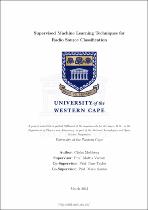| dc.description.abstract | Classification is one of the most fundamental aspects of scientific investigation. Astronomers have thus developed several classification schemes to try and make sense of the evolving properties of planets, stars and galaxies. One of the most popular ways to classify galaxies is according to their shape, or morphology, which has long been performed visually to produce annotated galaxy catalogues. However, visual inspection and manual annotation by astronomers will not be able to keep up with the expected data flow from next-generation sky surveys. In this context, the main objective of our study was to use deep learning to automate radio source characterization (that is detection, classification and identification) from image data efficiently. We adopted a pre-trained deep learning model called CLARAN (Classifying Radio Sources Automatically with Neural Networks) based on the Radio Galaxy Zoo Citizen Science Classification Project and applied it to a GMRT 610 MHz survey in the ELAIS-N1 region covering an area of 12.8 square degrees at a resolution of approximately 6 arcsec at a rootmean-square noise of about 40 µJy/beam. | en_US |

